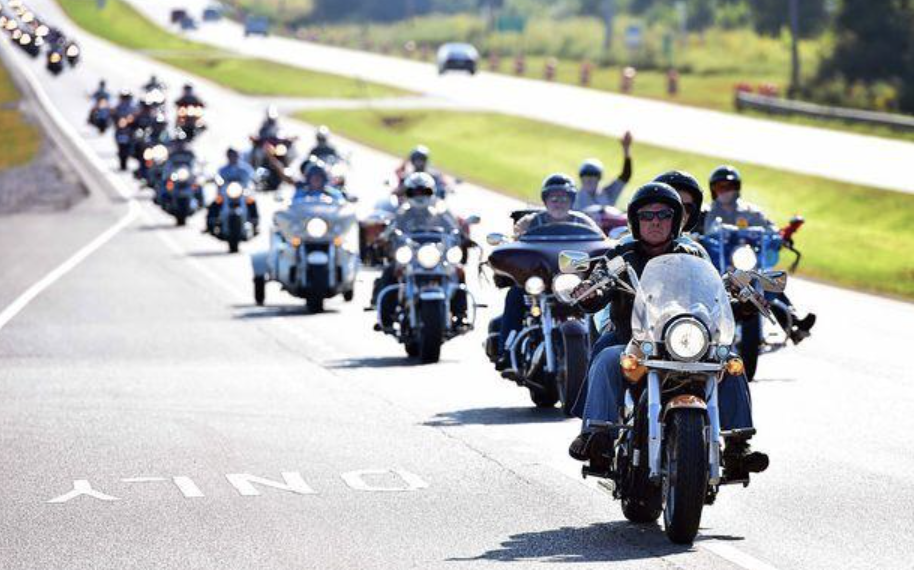One ride to remember the many
Marla Ballard
Over 100,000 motorcycle riders, stretching as much as 50 miles in length, are expected to gather for an annual occasion to commemorate and remember those who suffered an unjust and cruel event in history. The ride began in 1994 with eight motorcycle riders and an idea that has exponentially grown and is now a tradition. The eight would make the trip across North Alabama to retrace the approximate route of thousands of Native Americans who were brutally forced from their homes, robbed, and herded westward to reservations.
The Trail of Tears is the name given to the routes these native people were forced to walk. The trail was designated a National Historic Trail in 1987 through an act of Congress. The Trail of Tears was part of a series of forced relocations of approximately 100,000 Native Americans between 1830 and 1850 by the United States government known as the Indian Removal. All totaled there are over 30 Trail of Tears across the United States, they add up to a catastrophe of genocidal proportions. Some of the trails predated the Indian Removal Act of 1830.
During the autumn and winter of 1838-1839 a forced migration of the Cherokee people from their ancestral lands in Georgia, Alabama, Tennessee, and North Carolina to new territories west of the Mississippi River took place. Under the watch of armed troops, the Native Americans marched for four months. At every stop along the trail, funerals and burials were held. The native people died due to exposure to the elements, diseases, physical exhaustion, and malnutrition. Others traveled over water along the Tennessee, Ohio, Mississippi, and Arkansas rivers, until they reached the eastern edge of present-day Oklahoma
Darla Graves, then Executive of the Alabama Indian Affairs Commission and Jerry Davis, AL-TN Trail of Tears Corridor Committee Co-Founder initiated meetings and served on a committee that helped write the legislation for the Trail of Tears Corridor of North Alabama. On July 13, 1995, the legislation passed designating the Highway 72 route as an Alabama Trail of Tears Corridor.
In 1996 this overland route was recognized by the National Park Service as an official trail and added to their Trail of Tears National Historic Route brochure. A purchase of 80 trailblazer signs was made by the AL-TN Trail of Tears Corridor Committee and erected along Highway 72. Two Trail of Tears Historical Markers were also erected in Alabama, one in Bridgeport and one in Waterloo. In 1998 a third historic marker was placed at Ross’ Landing in Chattanooga, Tennessee.
The author of Riding to Remember and a founder of the Trail of Tears Commemorative Motorcycle Ride Jerry Shadow Wolf Davis has a vested interest in preserving the memories of his ancestors. A descendant of a full-blood Cherokee, he works tirelessly to educate others, ensuring the history of the Native American Indian is not forgotten. “Those who do not learn from history, are destined to repeat it,” said Davis. Riding to Remember explores the tragic history of the American Indian: from the usurping of their homes and land, the erosion of their customs and culture by European immigrants, to the current political climate.
Friday, Sept. 20 an unescorted ride will be held from Cherokee departing from the Cherokee Indian Fairgrounds to Ross’ Landing at 160 Riverfront Pkwy, Chattanooga, Tennessee. Then onto Bridgeport, arriving at 3 p.m., which marks the beginning of a Kick-Off Party in downtown Bridgeport at 615 Witcher Ave, Bridgeport.
“It will be family-friendly,” said Davis. “Kids bounce house, food trucks, and more will be at the kick-off party.”
At 5 p.m., opening ceremonies; 6 p.m., music entertainment begins; 7:30 p.m., John Stone and the Trailer Park Allstars; 9 p.m., fireworks and three best-bike giveaways; 9:30 p.m., John Stone and the Trailer Park Allstars (for vendor information call Randall Gibson 256-608-9542).
Saturday, Sept. 21 at 7 a.m. motorcyclists line-up on Main Street in Bridgeport to leave at 8 a.m. This ride follows US 72 across Northern Alabama from Bridgeport to Waterloo with a lunch and gas fill-up stop at Redstone Harley Davidson near Huntsville. Live music, vendors of motorcycle gear, Indian arts & crafts, and motorcycle ministries are there to greet riders. After the lunch stop the ride continues on to Waterloo where the festival continues. As the procession of riders pulls into the park at Waterloo they are greeted by thousands as they arrive at the Pow Wow celebration that has been set up by the City of Waterloo and the Native American peoples. Vendor booths, displays of Native American dances, custom bikes on display, raffles, food, fellowship, and the memory of why they are gathered are all part of the celebration.
The entire ride from Bridgeport to Waterloo is escorted by the Alabama State Police and local police of the various jurisdictions. The 31st Trail of Tears Commemorative Motorcycle Ride from Bridgeport to Waterloo, is held by Al-Tn Trail of Tears Corridor Association, Inc. There are no fees to join and no requirement to register for the ride. The ride takes place the third Saturday each September, rain or shine. For more information, go to: al-tn-trailoftears.net.





